Author: Marshall Schott
Originally bred in 1974 and released in 1990 by Washington State University, Centennial hops rapidly became a workhorse among American brewers and remains so to this day. Noted to be used in popular commercial beers such as Russian River’s Pliny The Elder and The Alchemist’s Heady Topper, Centennial has paved a solid path for itself, becoming a staple among brewers of hop-forward styles.
Alpha: 7 – 12%
Beta: 3.5 – 5.5%
Cohumulone: 23 – 27% of alpha acids
Total Oil: 1 – 3 mL/100g
Myrcene: 55 – 65%
Humulene: 10 – 20%
Caryophyllene: 5 – 7%
Farnesene: <1.0%
Linalool: 0.6 – 0.9%
Geraniol: 1.2 – 1.8%
ß-Pinene: 0.8 – 1.0%
Parentage: Brewers Gold, Fuggle, Golding, Bavarian, unknown
Referred to by many as Super Cascade, Centennial is said to impart characteristics of citrus, most notably grapefruit, as well as floral, herbal, and spicy notes. With few exceptions, most commercial examples of Centennial hop usage is in conjunction with other similar varieties, leaving us curious how it would present when used in a simple beer all on its own!
| MAKING THE BEER |
In order to allow the Centennial to be in the spotlight, I designed a recipe with a simple grist and clean yeast.
Centennial Pale Ale
Recipe Details
| Batch Size | Boil Time | IBU | SRM | Est. OG | Est. FG | ABV |
|---|---|---|---|---|---|---|
| 5.5 gal | 60 min | 35.0 IBUs | 5.3 SRM | 1.057 | 1.012 | 5.9 % |
| Actuals | 1.057 | 1.012 | 5.9 % | |||
Fermentables
| Name | Amount | % |
|---|---|---|
| ESB Pale Malt (Gambrinus) | 7.875 lbs | 68.48 |
| Pilsner (Weyermann) | 3.625 lbs | 31.52 |
Hops
| Name | Amount | Time | Use | Form | Alpha % |
|---|---|---|---|---|---|
| Centennial | 15 g | 60 min | Boil | Pellet | 7.3 |
| Centennial | 10 g | 30 min | Boil | Pellet | 7.3 |
| Centennial | 30 g | 15 min | Boil | Pellet | 7.3 |
| Centennial | 30 g | 5 min | Boil | Pellet | 7.3 |
| Centennial | 52 g | 3 days | Dry Hop | Pellet | 7.3 |
Yeast
| Name | Lab | Attenuation | Temperature |
|---|---|---|---|
| Safale American (US-05) | DCL/Fermentis | 77% | 59°F - 75°F |
Notes
| Water Profile: Ca 87 | Mg 1 | Na 10 | SO4 125 | Cl 62 | HCO3 200 |
Download
| Download this recipe's BeerXML file |
The night before brew day, I collected the water for this full volume no sparge batch, adjusting it with minerals and acid to my target profile, then weighed out and milled the grain.
I hit the flame under my kettle first thing the next morning, adding the slightly overheated liquor to my mash tun for preheating before stirring in the grain to hit my target mash temperature.
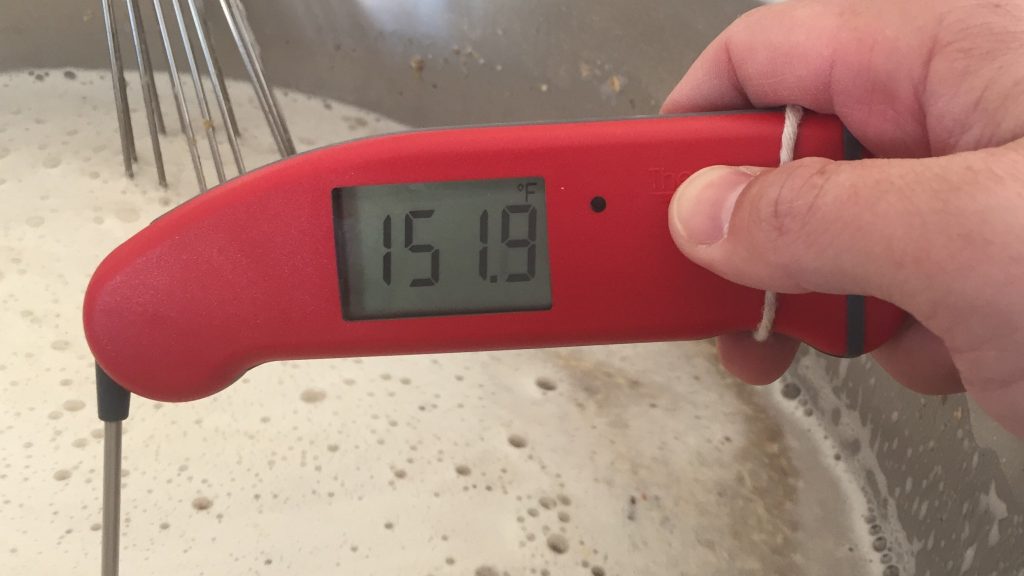
A measurement 15 minutes into the mash revealed I’d nailed the pH predicted by Bru’n Water.
After a 60 minute rest, I collected the full volume of sweet wort in my trusty graduated bucket before transferring it to a kettle.
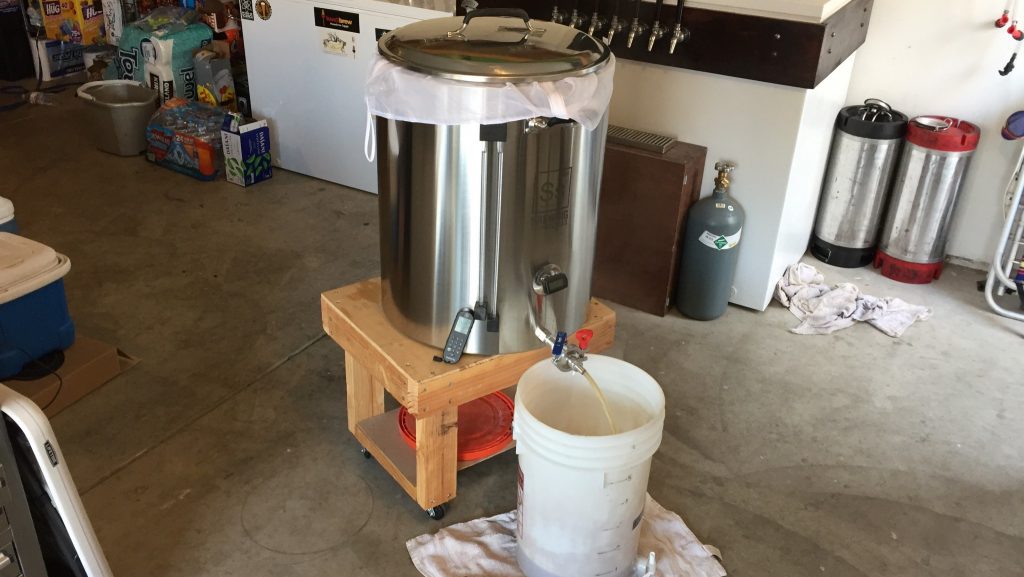
As the wort was heating, I measured out all of the Centennial hops that would be added to the kettle.
Once the wort had reached a rolling boil, I set a timer for 60 minutes and began making kettle hop additions.
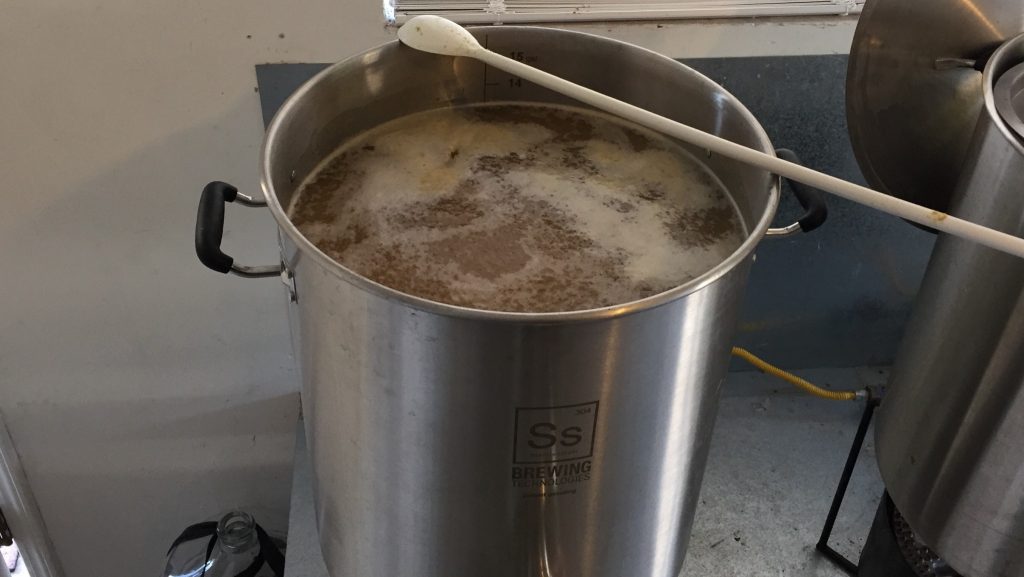
At the conclusion of the boil, I quickly chilled the wort to a few degrees warmer than my groundwater temperature, which is a bit warmer than my desired fermentation temperature.
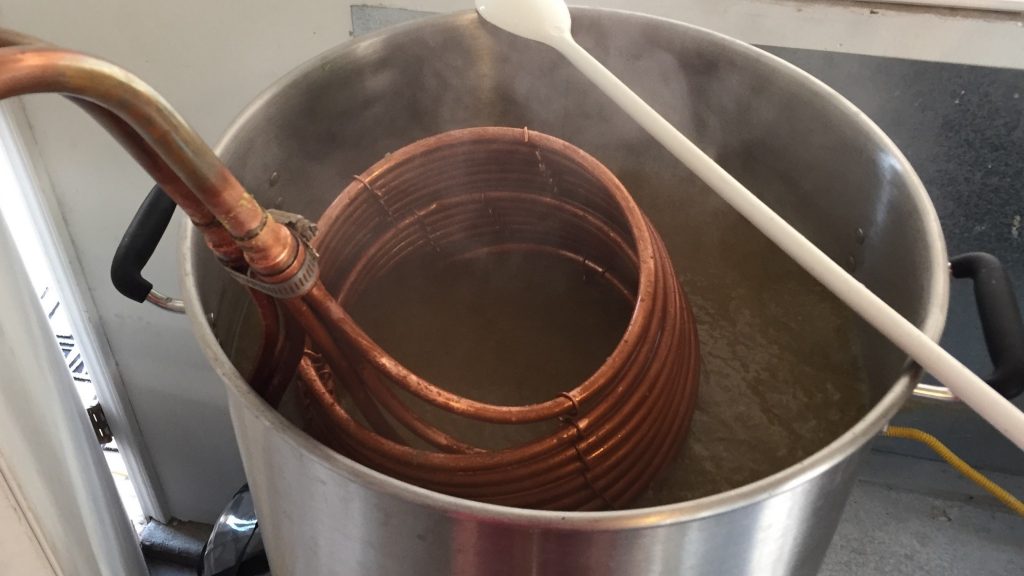
I took a refractometer measurement between stirs while chilling that showed a I’d achieved a respectable OG.
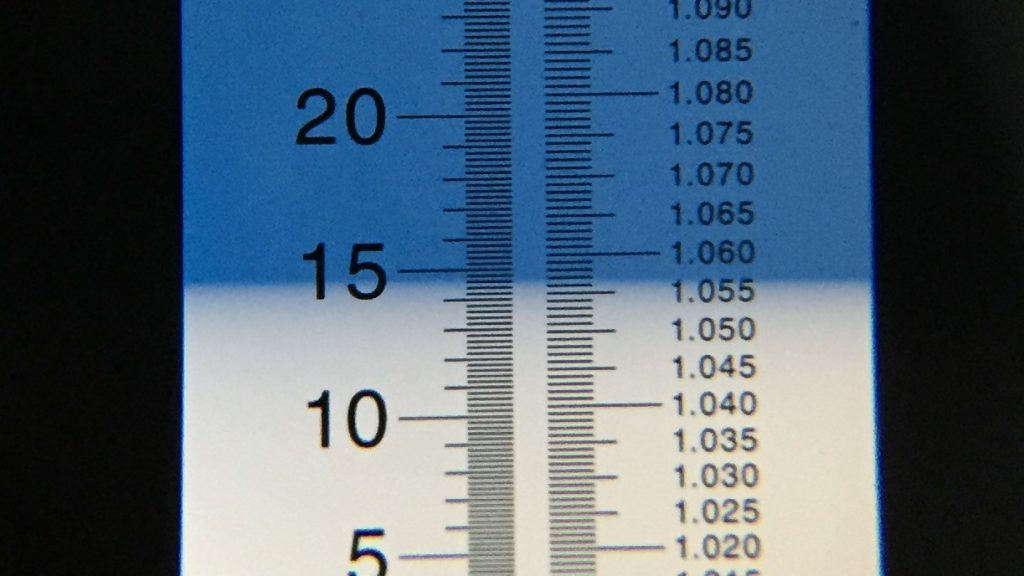
The chilled wort was transferred to a fermentor then placed in my cool chamber to finish chilling to my target fermentation temperature of 66°F/19°F.
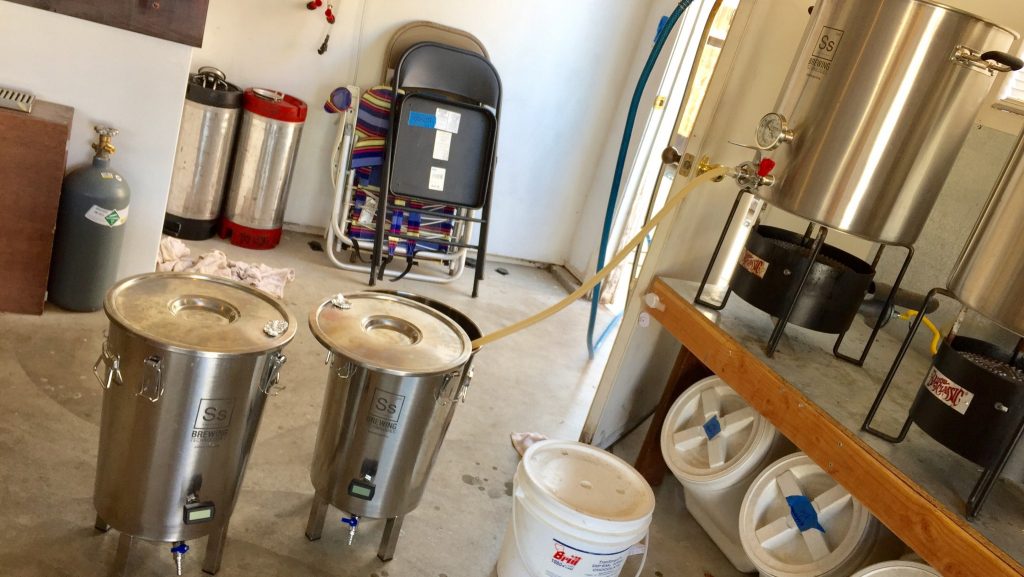
I returned about 4 hours later to pitch a vitality starter I’d made earlier with Safale US-05 dry yeast. The following morning, about 12 hours later, I noticed airlock activity indicating active fermentation. I allowed the beer to ferment for 3 days before bumping the temperature up to 72°F/22°C.
With signs of active fermentation absent after another 3 days, 6 days total, I took a preliminary hydrometer measurement and added the Centennial dry hop charge.
After 3 days on the dry hops, I took a second hydrometer measurement that matched the first, confirming fermentation was indeed complete.
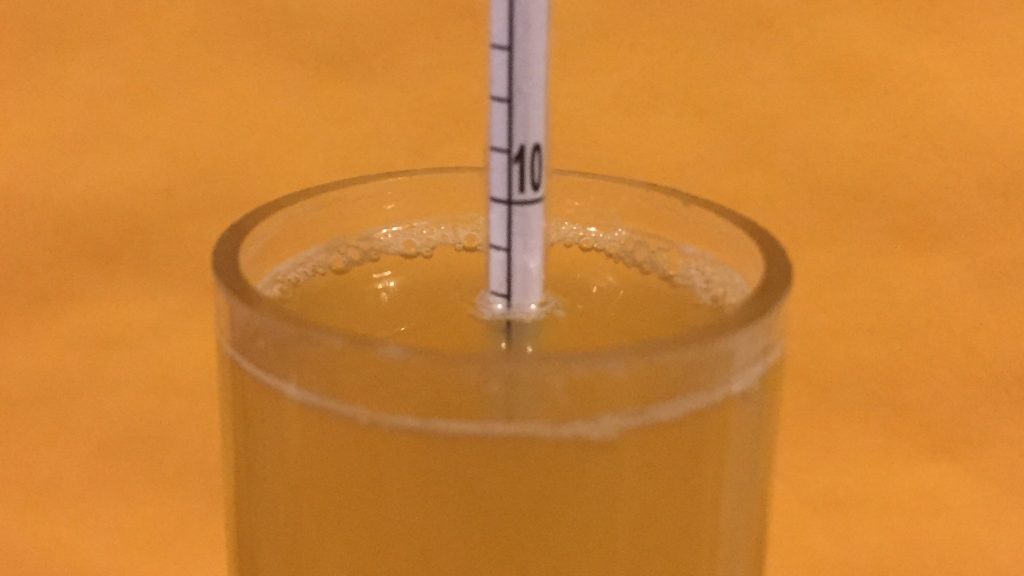
The beer was cold crashed, fined with gelatin, then kegged 9 days after being brewed.
The filled keg was placed in my keezer where the beer underwent a brief period of burst carbonation before I reduced the gas to serving pressure. After a few days of cold conditioning, the beer was carbonated, clear, and ready to serve!
| METHOD |
Participants were instructed to focus only on the aromatic qualities of the beer before evaluating the flavor. For each aroma and flavor descriptor, tasters were asked to write-in the perceived strength of that particular characteristic on a 0-9 scale where a rating of 0 meant they did not perceive the character at all and a rating of 9 meant the character was extremely strong. Once the data was collected, the average rating of each aroma and flavor descriptor was compiled and analyzed.
| RESULTS |
A total of 12 people participated in the evaluation of this beer, all blind to the hop variety used until after they completed the survey. The average aroma and flavor ratings for each descriptor were plotted on a radar graph.
Average Ratings of Aroma and Flavor Perceptions
The 3 characteristics endorsed as being most prominent by participants:
| Aroma | Flavor |
| Citrus | Floral |
| Spicy/Herbal | Earthy/Woody |
| Earthy/Woody | Spicy/Herbal |
The 3 characteristics endorsed as being least prominent by participants:
| Aroma | Flavor |
| Onion/Garlic | Berry |
| Berry | Onion/Garlic |
| Dank/Catty | Apple/Pear |
When asked to rate the pungency/strength of the hop, the majority of tasters perceived it as being moderately pungent.
Tasters were then instructed to identify beer styles they thought the hop would work well in.
Finally, participants were asked to rate how much they enjoyed the hop character on a 1 to 10 scale.
My Impressions: Prior to sampling this single-hop Pale Ale, I fully expected to be greeted with a strong grapefruit character and maybe a touch of pine. But that’s not what I got, not at all. Instead, I found any citrus notes to be muted, overshadowed by a blend of floral and spice that immediately took me back to my early days of drinking when “craft beer” basically just meant Sierra Nevada Pale Ale. It took me a few samplings to really wrap my mind around what it was I was tasting, wholly a function of knowing the hop that was used and having a very specific idea of what to expect. While a bit of a shocker, I can’t say I didn’t enjoy this beer, in fact as other participants pointed out, it was reminiscent of earlier times and was quite crushable to boot.
| CONCLUSION |
I believe it was Socrates who said something about true wisdom coming from knowing that one knows nothing. This experience proved to me I’m far from wise, as I’ve assumed for years to know the character imparted by Centennial hops to point of referring to is a favorite variety of mine. I’ve tasted a particular commercially available beer hopped with Centennial once before, it was years ago, I’d already knocked a few other beers back, and I was’t necessarily in evaluation mode, so I can’t really say how I perceived it then. While the beer I made for this edition of The Hop Chronicles was perfectly fine, I’m realizing now what I thought I knew about Centennial was likely built on my perception of beers where it was used in conjunction with other hops. To this end, I remain a huge fan, though I’ll likely shy away from using it on its own in the future.
A comparison between this data and that from a prior edition of The Hop Chronicles certainly seems to support the notion that Centennial is a “super” Cascade, both imparting very similar characteristics while the former clocks in with a slightly higher AA%. With modern hops with new aromas and flavors popping up so frequently, Centennial is a classic variety that can hold its own in old school Pale Ale as well as meld beautifully with other hops in newer beer styles.
If you have any thoughts on Centennial hops, please feel free to share them in the comments section below!
Support Brülosophy In Style!
All designs are available in various colors and sizes on Amazon!
Follow Brülosophy on:
FACEBOOK | TWITTER | INSTAGRAM
If you enjoy this stuff and feel compelled to support Brulosophy.com, please check out the Support Us page for details on how you can very easily do so. Thanks!


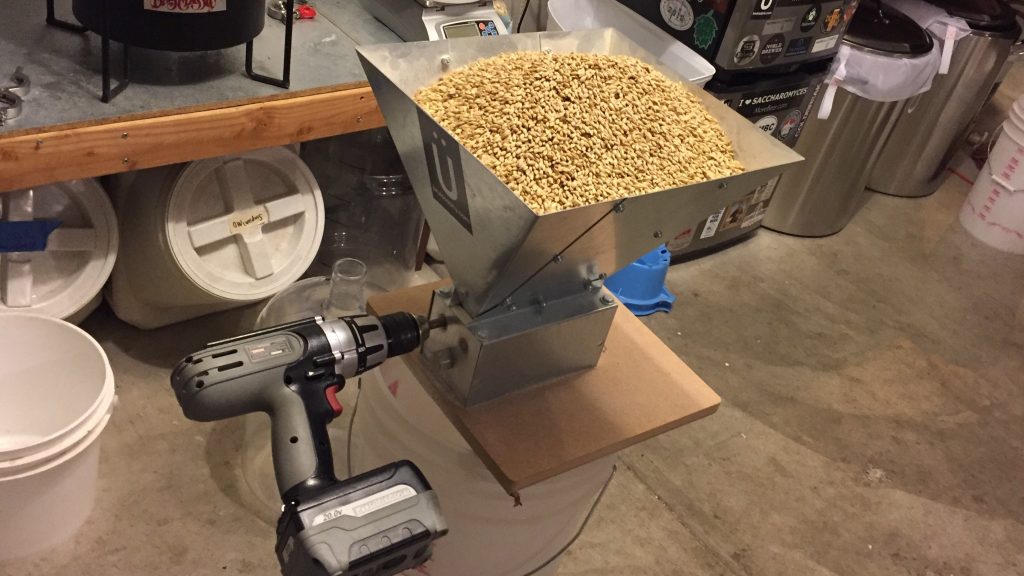
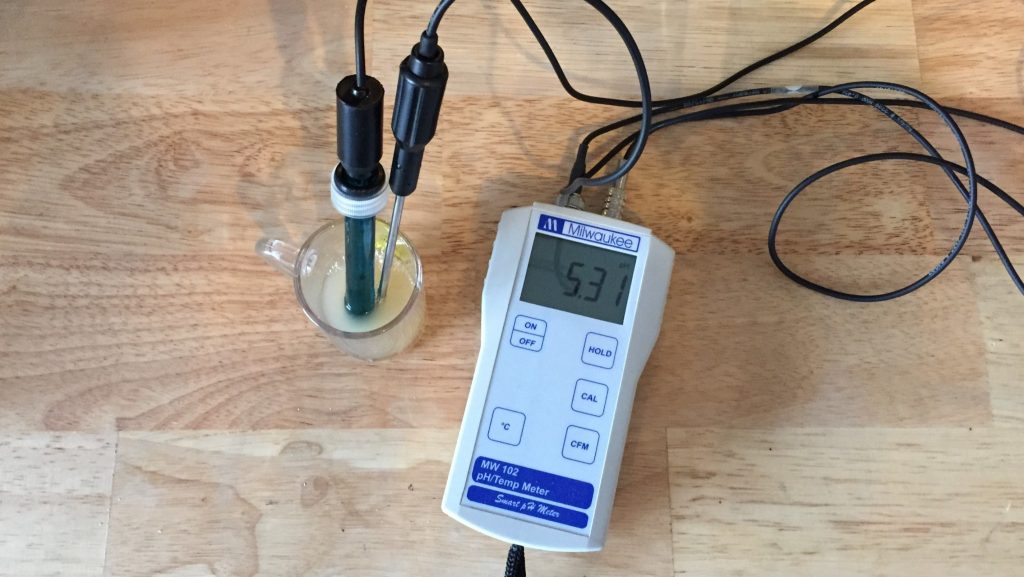
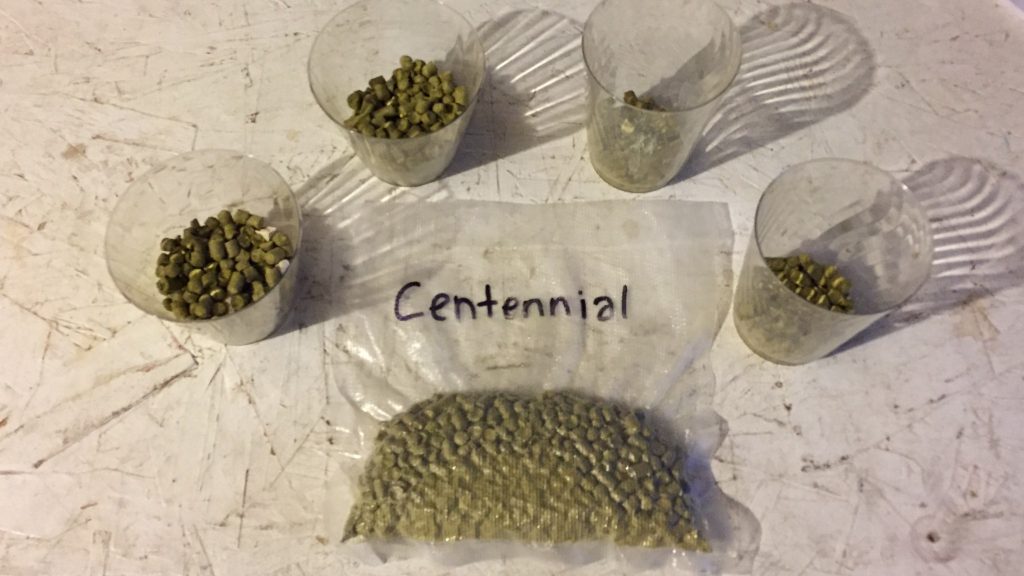
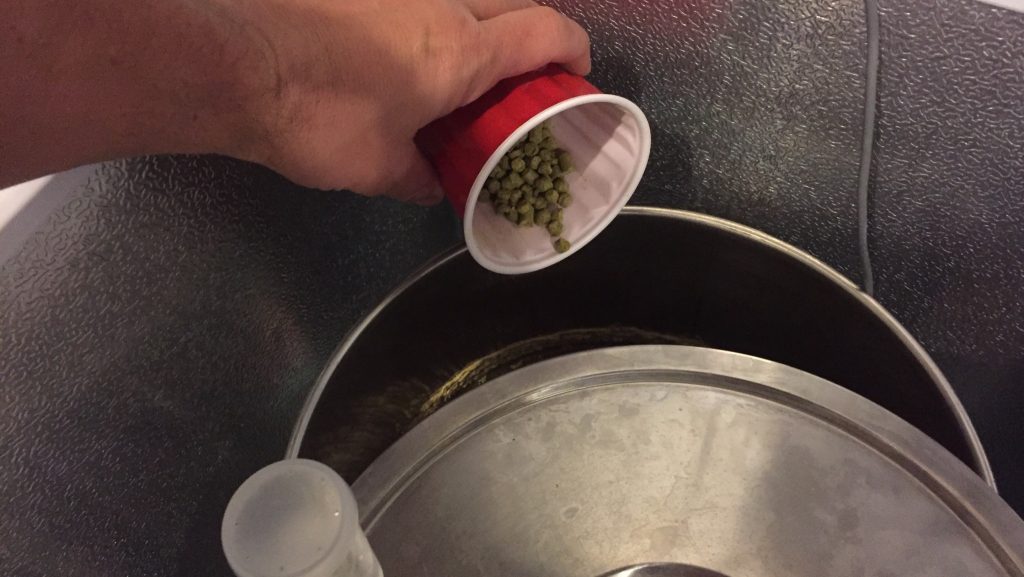
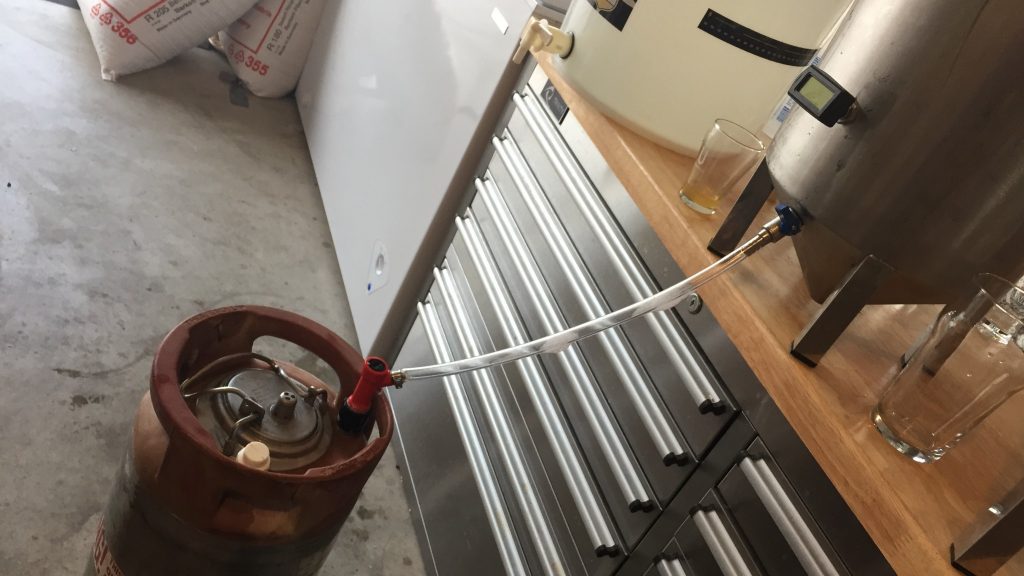
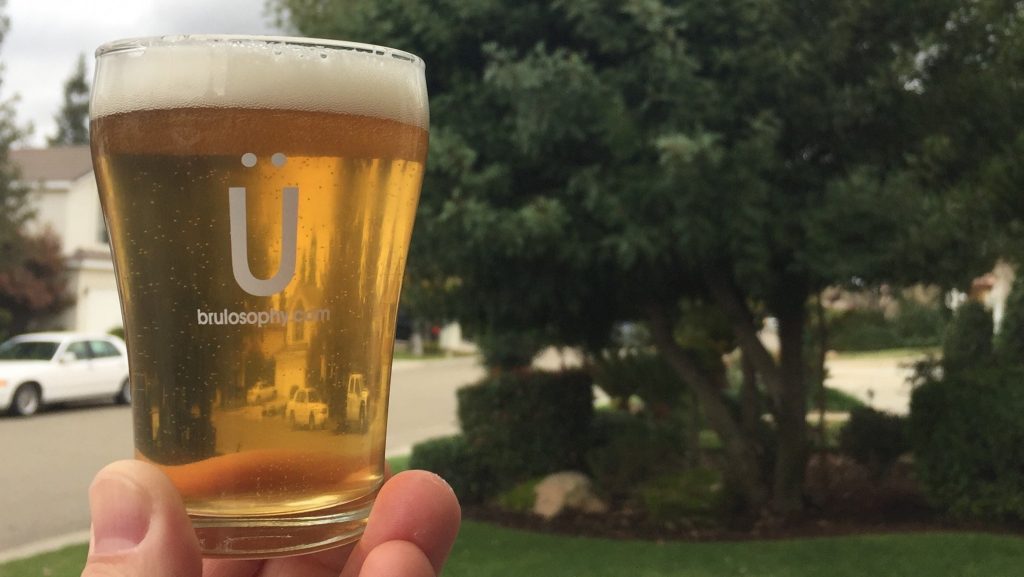
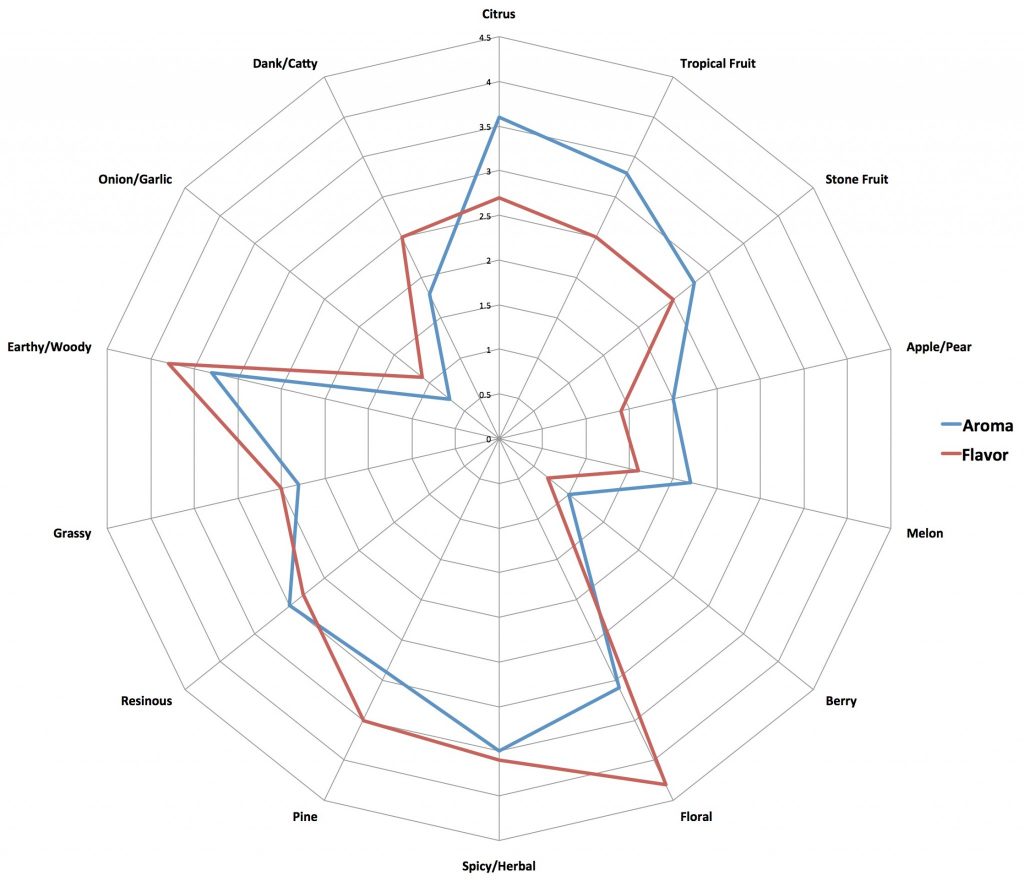
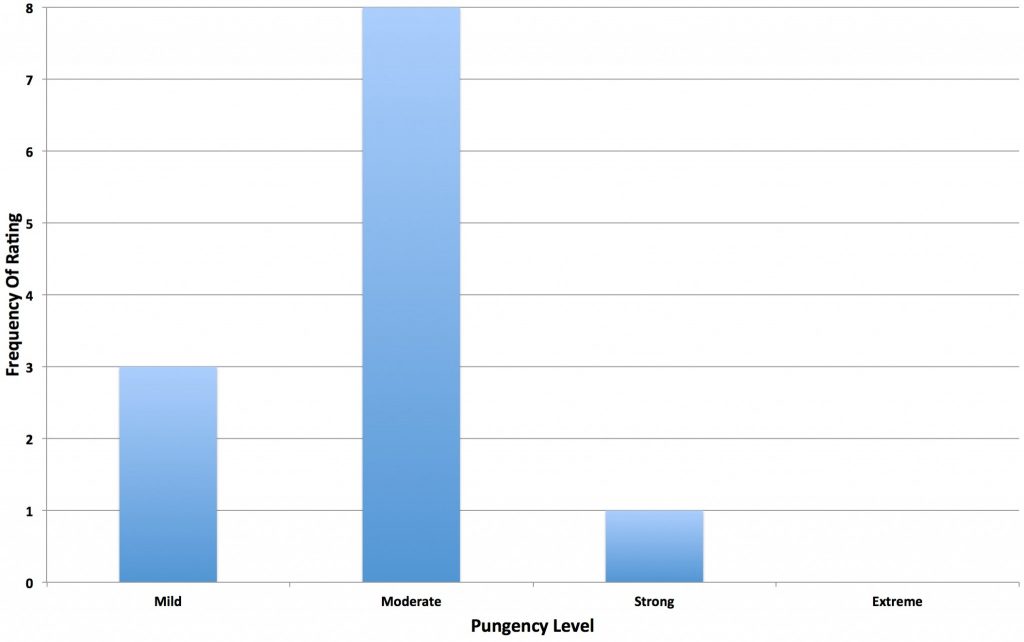
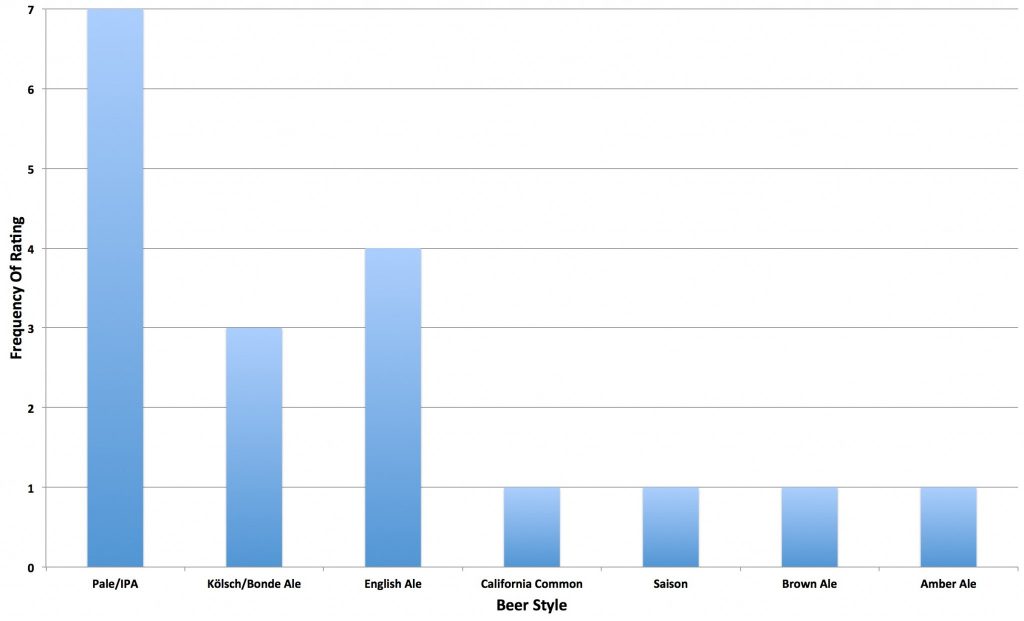
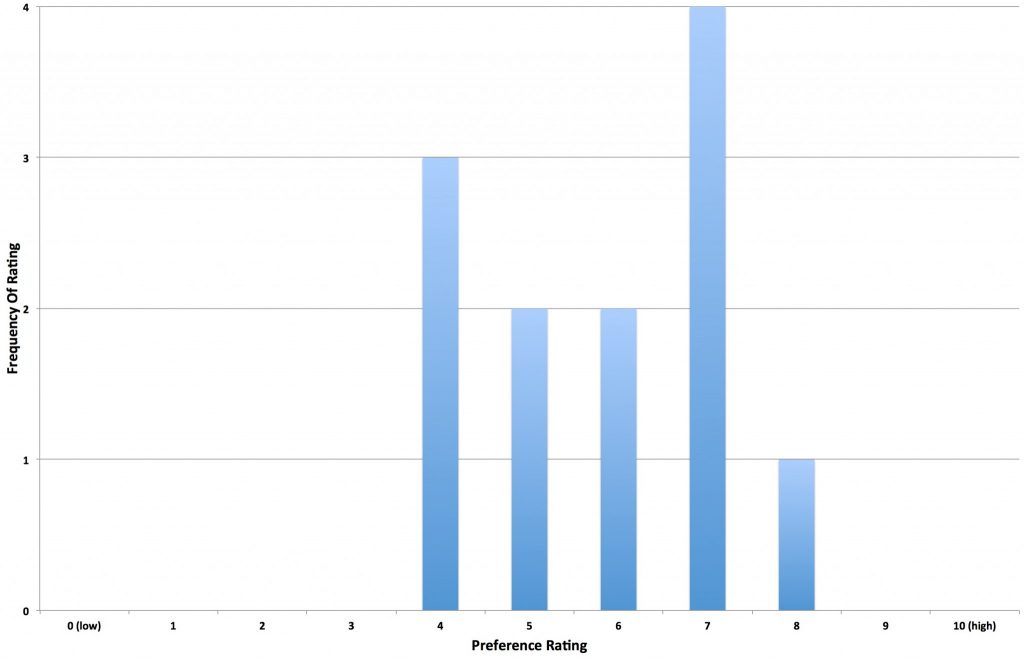










50 thoughts on “The Hop Chronicles | Centennial (2015) Pale Ale”
The second SMASH I ever made was with Centennial and I was likewise surprised by how little the actual beer tasted like I expected it would. My first SMASH was with Chinook and that tasted EXACTLY like I thought it would. Weird.
Good timing. I just added the dry hops to an all Centennial IPA. I love Bell’s Two Hearted, so hopefully this one turns out great.
I made a two hearted clone and absolutely loved it. Centennial does well by itself. Mine smelled kind of like fruity pebbles in terms of aroma.
Great article. I’ll be forever biased by my hometown great IPA, an all-Centennial legend, Bell’s Two Hearted IPA. Get your hands on some!
I’ve had it many times, it’s a fine beer!
I love Centennial hops – I share Todd’s fondness for Two Hearted. I did brew a Two Hearted clone once using a blend of Cascade and Columbus instead – and I definitely got grapefruit there. I know you can sometimes find a blend called “Centennial-Like” which is supposedly some blend of cascade and columbus. I wonder if that’s where the grapefruit expectation comes from?
I have also found centennial to be a bit perplexing. The aroma of the pellets in the bag has always been underwhelming, not very pungent, and kind of old and earthy (and this has been several different bags from different crop years and suppliers), not citrusy and fresh like I would expect. I’ve made a couple single hop beers with it and was very surprised by how insanely fruity the aroma was (for the first week on tap or so), it reminded me of tropical skittles… I have never understood the comparison to cascade… maybe cascade was the only citrusy hop available to compare it to when centennial was released?
I would like to see these chronicles done with less bittering additions and more flavor/aroma. I feel the boil additions under 60 minutes don’t provide much other than more bitterness. I think whirlpool and multiple dry hop additions would provide a better analysis of what is capable of the hop.
I wholeheartedly agree. I study dryhop additions to learn the essence of a hop, not bittering, too many variables there in the grains to learn much.
If you want to do your own hop chronicle at home, Bell’s Two Hearted (one of my favorite beers) is supposedly single hopped with Centennial. If there is even an example of how my homebrew isn’t commercial beer it is that beer. I’ve tried and tried to “clone” it and my versions are never as complex as Two Hearted. Either way, I will be drinking a Two Hearted while rereading this article tonight.
The clone recipe from AIH (Dead Ringer IPA) all grain kit I have on tap is really close to Bells Two Hearted. Centennial heavy as you could want. I tried them side-by-side and I vainly like mine better.
I have made a clone of Two Hearted 3 or 4 times and it wasn’t until the last time that I found the proper recipe and that made all the difference. You have to buy Midwestern Ale yeast from the Yeast Bay to get it to taste right. Use this recipe but use the Midwestern Ale yeast instead of Chico. https://www.homebrewersassociation.org/homebrew-recipe/bells-two-hearted-ale-clone/
Centennial is one of my favorite hops. Am I alone in feeling like it has almost a lemon/lime quality?
Yikes, I’ve never gotten a lemon/lime quality from it, but my palate is terrible. I’ve always gotten a spicy/pine/grassy taste. Apparently (according to Marshall’s graph) I’m the only one who gets grassy from it, but that was the clincher that made me decide against doing a Centennial SMASH again.
I’ve had good results with Sorachi Ace for lemon/lime flavor in the 30-minute range, but if it is too late in the boil it gets weird…in my experience.
You are not alone. I did a single hop IPA with Centennial that was dominated with a lemon zest flavor and aroma. It was quite pleasant and complex for a single hop.
I did a Centennial IPA recently that turned out pretty bad, at least so far. I admit that I completely over-did the dry hop. I added a pound of Centennial to a 6 gallon batch. It made the beer VERY bitter, and it now has an odd roasty,dusty flavor. Maybe that is the “earthy” people are mentioning, but it’s earthy to the max due to how much I added. Definitely not as much of that fruity pebble character that I was hoping for. I’m going to way dial back the Centennial dry hops in the future.
Dust flavor = stale hops
I did a Centennial pale back in 2013 and it was very flora too. The super Cascade description is not right as Cascade is mostly citrus. They are different hops, both unique.
Our last edition of The Hop Chronicles was on Cascade and it would seem most blind tasters didn’t find it overwhelmingly citrus forward.
My only experience with using centennial by itself was in a gluten free beer made with sorghum extract and flameout centennial. I thought it tasted like orange juice. Was quite nice (would have been better if not GF).
You could brew a smash with the same hop every year and get variation of the hops flavors. Certain things are predominant some years but others not.
Presumably, indeed.
Centennial is one of my favorite hops, it plays extremely well with others. One thing that I will mention is that not all years and/or sources are equal (for Centennial and many other varieties). The 2015 pellets I had were not nearly as aromatic as my 2014, in fact I just tossed about 4oz of them due to my disappointment. In 2010, I won the IPA category of a large regional competition with a two hearted clone using only some incredibly lush Centennials. Unfortunately, we as Homebrewers can’t do bale selections and we get what we can get. Also, I’ve been noticing a lot of inconsistency in hoppy beers from smaller breweries that I believe is coming from differences in hops sourced from a variety of locations. I sometimes wonder if at some point in the future commercial beers might be Identified by the terroir and vintage of the hops used.
British brewers barely use it. If they go for hops that fit with British styles they tend to go for Cascade and Willamette. The more crafty brewers here prefer Chinook (Brewdog’s favourite), Simcoe, Citra, Columbus, Mosaic, Nelson, Galaxy, etc.
According to this they should try it out more!
totally – It will become the new way to differentiate in a saturated market with a finite number of combinations possible – the year and soil dynamics that expresses itself as certain flavor/aromas characteristics. The great thing about this theory is its easy to test – the hardest part would be sourcing the hops. You’d have to find different distributors, and years etc. Everything else about the batches could be exactly the same.
it was actually Op Ivy…”all I know is that I don’t know nothin.” 😉
Thanks for doing this, I’ve been hoping you’d do some of the more common/”traditional” hops. It really helps put some of the others in perspective.
It’d be interesting to integrate this with the XBMT side of things. Recently, I’ve been looking at hop substitution charts and noticed there’s absolutely no consistency. Hop A is a substitute for Hop B, but not the other way around, and Hop B is a substitute for Hop C which is drastically different from Hop A, etc.
It’d be cool to combine this analysis with side by side brew (Glacier vs. Willamette, Cascade vs. Centennial, Bravo vs. Columbus, etc.) I listened to the last Session Marshall went on, thanks for putting me on to Scott Janish’s site. The hop replacement calculator seems really interesting, although it seems like it has some of the same consistently issues present in other charts.
We’ve got some hop comparison xBmts coming up shortly 🙂
+1 on seeing a hop comparison xBmt, especially for the “C” hops
It’s cooooooooming!
Why was there no first wort hop additions used? For SMASH beer, many different addition times likely would have created a more well rounded hope profile.
There is no point to FWH:
https://brulosophy.com/2015/07/06/the-first-wort-hop-effect-exbeeriment-results/
I respectfully disagree and feel this is a poor example of FWH use case as it is a non-hopforward beer style and uses subtle hops. I’ll a also add that honey malt in that quantity creates a cloying flavor that dominates other delicate ones.
I believe using a single malt or minimal specialty with any C hop and you are going to tell the difference between a FWH beer and a non-FWH.
This beer was served to a bunch of people at a homebrewers convention, mostly in the morning before they started drinking. Not a single person, all of whom were blind to the style and variable, described the beer as cloying whatsoever.
Your belief that FWH would be more noticeable in a mostly base malt and C hop beer is interesting, I’m not sure I understand how that can be on a logical level, you I sure as beans plan to test it out 🙂
I still FWH because it’s convenient and eliminates the risk of a volcanic eruption when adding the first kettle hop addition.
Let’s say there is an effect doing FWH. If you are making a very hoppy beer, what is going to dominate the flavor more, dry hops or the FWH addition? I see it as a technique for beers with minimal hops and subtle flavors, if then.
I find the procedure for making this beer a bit odd and troublesome for truly evaluating the flavor from a given hop. In my experience, you need to dry hop after getting the yeast out of the beer. If you dry hop while there is still significant yeast suspended in the beer (as I would bet there was here with US-05 and only 6 days since pitch) you will lose a good amount of hop flavor when that yeast drops or is dropped via finings. I also find the hops used tend to have a rougher more earthy quality to them after the yeast drops or is dropped via finings. Almost like some flavors/oil are being selectively stripped from the beer by the yeast while others remain. I think that the reason a lot of people feel gelatin strips hop flavor has to do with the timing of when it is used and also wether or not there is still yeast in the beer. Individual yeast strain may play a part in this too but I won’t draw any conclusions with regard to that. I won’t even get into the potential for biotransformation and why effects that may or may not have had.
TL:DR – You need the yeast out of the beer before the dry hop for the best expression of the hop. Especially when most of the character is coming from the dry hop.
While we generally wait until fermentation is complete, I’d recommend googling “biotransformation dry hop” 🙂
I am familiar. I think I’ll save my constructive thoughts and experiences for another outlet, thanks.
Sounds like you are very dogmatic and uninformed to me. Tons of people dry hop with active yeast and prefer the flavor. I am one. It’s one thing to offer a suggestion, another to say it has to be done this way, I am God.
There are some decent professional and some successful homebrewers that take a somewhere in between approach. Some activity left, but not necessarily still a whirling soup. At 6 days in, most of my beers are done or nearly so.
https://byo.com/stories/issue/item/3187-advanced-dry-hopping-techniques
Thanks Malcom. I am not looking to engage the tired argument that there is a best way for people to dry hop their beer. I don’t always dry hop at the same time or remove the yeast in my own beer. However what I am suggesting here is a more consistent way for the hop chronicles to evaluate each hop for a better evaluation of what you will get from them. Considering all the ways in which the yeast can effect the character you get from a dry hop, removing the yeast from the equation seems like a effective means of being more consistent in your process. Especially since you guys don’t all dry hop at the same time or even use the same variety of yeast. It should also be mentioned that about half of the hop chronicle articles don’t mention exactly when the dry hops were added.
Thanks for the comment. I will say the THC series is a work in progress. Good, Better, Best is certainly subjective, but settling on a singular method isn’t.
Then again, I’d challenge the idea that even with the same exact times and recipes (times, temps, yeast etc), there is still a good amount of variability between the brewers, the equipment, or process. It’s an evolution of concept. Getting everyone the same equipment isn’t feasible at this time; however, agreement on when and how (and yeast) – that has been and will continue to be discussed.
Also, I personally do not find the dry hop method discussion ‘tired’- I enjoy them!
It’s not the discussion that’s ‘tired’. It’s the oft mentioned ‘best way’ that many will still espouse across the web. As if there is one. I was merely suggesting a way of removing a variable from your process but yes, others there will remain. Yeast seems like a big one and one’s that can easily be changed. Good luck everyone.
I couldn’t agree more that people espousing a “best way” is entirely “tired.” There’s a lot of conjecture out there, to be sure!
uh oh, you touched a raw nerve…. I have to say that secondary is an appropriate time to dryhop, after alot of the yeast settled and is a good standard to offer us participants regarding our own trials that we want to share with you
I’d always thought of the ‘best’ way to dry hop was with a Randallizer. I mean how much closer could you get to the process than that?
Of course practical limits come into play, which is really the difference between any dry hopping method – your available equipment and available time typically dictate more what method you use rather than what is truly the best way to get fresh hop oil smells in your glass.
Interesting results. When I first started brewing Centennial was my go to C hop. I brewed a number of variations that were magnum for 60, and then a bunch of Centennial after the 15 minute mark. I never perceived the floral spice flavors. I think using Centennial as the bittering hop leads to this flavor change.
I will also say that I took a break from brewing (and most beer in general) from 2012-2015, when I started brewing again I went to my old recipes. I got this very green (the color, not unfinished beer) flavor from my Centennial beers. I assumed it was being out of practice with water from another city. Then I went to Russian River and had a Pliny…The same flavaroma was there. Not the same grapefruit I was expecting from my earlier days of brewing.
Either my perception of flavor has shifted, or there are differences in the Centennial I’m getting now. I think I’m blaming my taste buds more than the presumably genetically identical plants lol
For a full 5 gallon batch of this, what is the amount of water and strike temp for the batch?